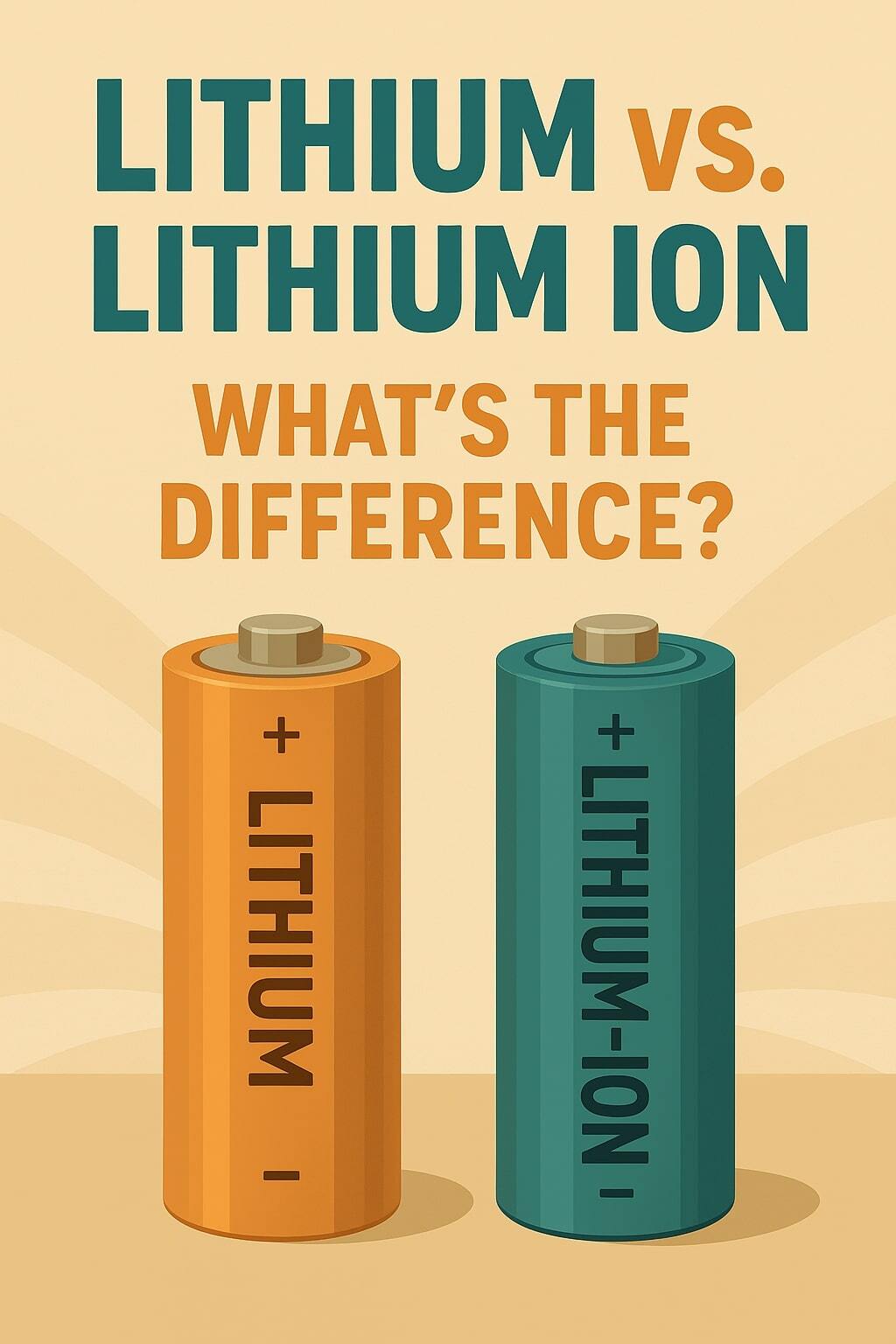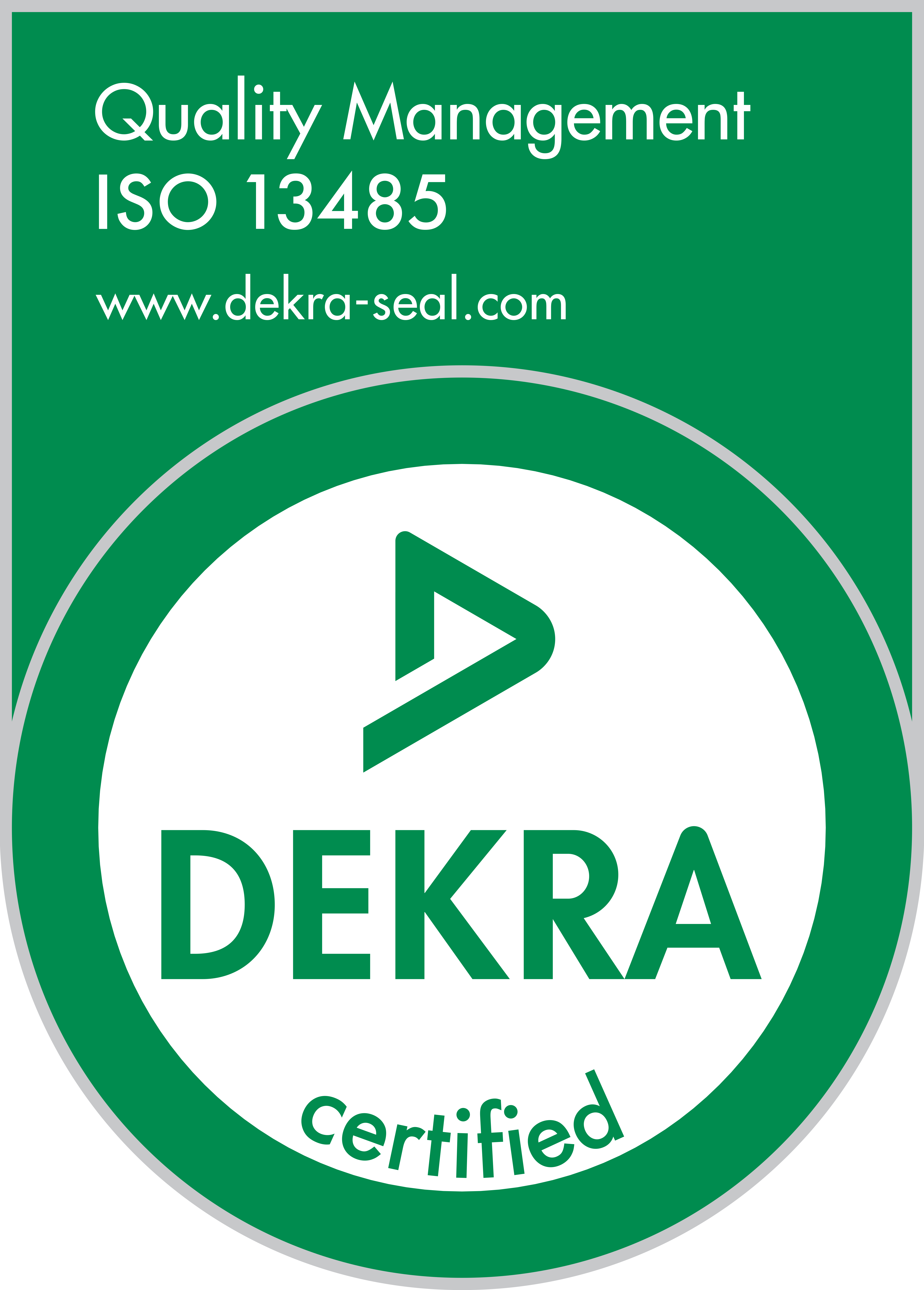Lithium and lithium-ion batteries are often used interchangeably in conversation, but they are distinct battery technologies with different structures, uses, and advantages.
While lithium batteries are primary, single-use batteries, lithium-ion batteries are rechargeable and have become the standard for portable electronics, electric vehicles, and energy storage systems.
Understanding the key differences between these two types of batteries is crucial for selecting the right power source for specific applications.
That’s why we’re going to explore the composition, energy storage capacity, safety concerns, costs, and environmental impact of lithium and lithium-ion batteries to provide a comprehensive comparison you can use before making your next purchase.
Composition and Structure of Lithium vs. Lithium-Ion Batteries
Understanding the composition and structure of lithium and lithium-ion batteries is fundamental to grasping their differences.
As you probably guessed, both of these popular battery types contain lithium, BUT they use it in distinct forms and structures, impacting their performance, application, and safety.
Lithium Batteries
Lithium batteries are primary batteries that contain metallic lithium as the anode. They are non-rechargeable and designed for single-use applications.
The lithium metal is highly reactive, providing a high energy density, making these batteries compact and lightweight.
However, their reactivity also poses risks of overheating and fire, especially if damaged or improperly disposed of (we’ll talk more about their safe use in just a moment).
The electrolyte in lithium batteries typically consists of lithium salt dissolved in an organic solvent, allowing for efficient ion transport. These batteries are often found in small electronic devices such as watches, calculators, and even medical devices, where longevity and compact size are prioritized over rechargeability.
Lithium-Ion Batteries
On the other hand, lithium-ion batteries use lithium compounds rather than pure lithium metal as the electrode material.
These compounds, such as lithium cobalt oxide or lithium iron phosphate, are less reactive than metallic lithium, enhancing safety and enabling recharging. Lithium-ion batteries are constructed with a layered structure, consisting of a positive electrode (cathode), a negative electrode (anode), a separator, and an electrolyte solution.
The electrolyte in lithium-ion batteries is a lithium salt dissolved in an organic solvent, similar to lithium batteries, but optimized for cycling stability. The separator prevents direct contact between the anode and cathode while allowing lithium ions to pass through during charging and discharging cycles.
The fact that they’re rechargeable make lithium-ion batteries ideal for high-drain devices like smartphones, laptops, electric cars, and all kinds of power tools.
Their popularity is also helped by the fact that these batteries can undergo multiple charge-discharge cycles without significant capacity.
Common Uses for Lithium and Lithium-Ion Batteries
Lithium and lithium-ion batteries get used for different purposes, largely based on their chemical composition and rechargeability.
So, before you go purchasing one or the other, let’s talk about common uses for each.
Let’s start with popular applications for lithium batteries.
-
Consumer Electronics: Lithium batteries are used in low-drain devices such as watches, calculators, and remote controls, where a long-lasting, single-use power source is sufficient.
-
Medical Devices: As we touched on a moment ago, lithium batteries are also preferable for important medical devices like pacemakers, hearing aids, and glucose monitors because of their reliable, long-lasting power.
-
Military and Aerospace: Lithium batteries do well in cold temperatures, which makes them great for all kinds of vehicles and specialized equipment, including military communication devices and even satellite systems.
-
Backup Power and Emergency Systems: Because of their long shelf lives, lithium batteries are ideal for emergency power systems, such as flashlights, alarms, and security systems.
And now for the most common uses of lithium-ion batteries…
-
Consumer Electronics: Lithium-ion batteries are the go-to choice for laptops, smartphones, tablets, and cameras because they can be recharged and they have high energy density.
-
Electric Vehicles (EVs): Need to get around? Lithium-ion batteries can power electric cars, motorcycles, and electric scooters (including mobility scooters), providing a higher range and quicker recharging capabilities than traditional lead-acid batteries.
-
Renewable Energy Storage: Lithium-ion batteries can store excess energy generated by solar panels and wind turbines, enabling a more consistent power supply from these clean energy sources.
-
Power Tools and Industrial Equipment: Rechargeable lithium-ion batteries are preferred for cordless drills, saws, and industrial machinery, too. They deliver consistent power and faster recharges.
-
Aerospace and Defense: Lithium-ion batteries are increasingly used in drones, aircraft, and military equipment for their lightweight nature and reliable performance in various conditions.
Energy Storage and Power Capacity
Energy storage and power capacity are crucial to consider when comparing lithium and lithium-ion batteries.
While both battery types contain lithium, their ability to store and deliver power differs due to their structural differences and chemical compositions.
So, once again, let’s do a head-to-head comparison.
Lithium Battery Capacity
Lithium batteries are known for their high energy density, making them ideal for applications where long-lasting power is required, such as in military equipment, medical devices, and emergency backup systems. These batteries can store significant power in a compact size, allowing them to operate for extended periods without recharging.
However, because lithium batteries are non-rechargeable, their power capacity is limited to the initial charge they receive.
Once depleted, they must be disposed of and replaced, making them less suitable for applications that require frequent power cycling.
Lithium-Ion Batteries Capacity
By now, you know that lithium-ion batteries are rechargeable, which means they can undergo hundreds to thousands of charge-discharge cycles while maintaining a relatively consistent energy output.
This makes them much more suitable for applications that demand frequent power cycling, such as smartphones, laptops, and EVs.
While the power capacity of lithium-ion batteries is also high, it can degrade over time due to repeated charging cycles.
Factors such as temperature, charging speed, and depth of discharge can affect the battery's overall capacity and lifespan.
Lithium-ion batteries can be engineered with different cathode materials to optimize power output and storage capacity. For example, lithium iron phosphate (LiFePO4) batteries prioritize cycle stability, while lithium cobalt oxide (LiCoO2) batteries focus on higher energy density.
So, while lithium batteries typically offer higher initial energy density, they lack rechargeability, making them less practical for high-drain applications.
Though slightly lower in initial energy density, lithium-ion batteries provide greater long-term power capacity through multiple charge cycles, making them ideal for electric vehicles and renewable energy storage systems.
Safety Considerations: Lithium Fires, Risks, and Prevention
Safety is important when comparing lithium and lithium-ion batteries, as both types present potential risks of overheating, fire, and thermal runaway.
Like we said before, lithium batteries contain pure lithium metal, a highly reactive material that can become dangerously unstable if exposed to high temperatures, punctured, or improperly disposed of. This instability can lead to thermal runaway, a condition in which excessive heat triggers a chain reaction of overheating, combustion, and even explosions.
What’s worse, the electrolyte in lithium batteries is often flammable, further increasing the risk of fire in the event of physical damage or overheating. These batteries are commonly used in critical applications such as medical devices and military equipment, where failure could result in severe consequences.
Therefore, strict handling, storage, and disposal guidelines are essential to minimize fire hazards.
While generally considered safer than pure lithium batteries, lithium-ion batteries are not without risks.
As they rely on lithium compounds rather than pure lithium, this reduces their reactivity a bit. That doesn’t mean they still can’t overheat, though.
Lithium-ion batteries can still experience thermal runaway, particularly if they are overcharged, short-circuited, or physically damaged.
If the separator that prevents direct contact between the anode and cathode becomes compromised, the electrolyte can ignite, resulting in a fire.
To mitigate these risks, lithium-ion batteries are often equipped with protective circuits designed to prevent overcharging, overheating, and short-circuiting. Manufacturers may also include thermal sensors and pressure valves to detect and respond to excessive heat buildup.
Preventive measures are essential for reducing the risks associated with both lithium and lithium-ion batteries.
Overcharging is a common cause of overheating, so it is crucial to use chargers that are specifically designed for lithium-ion batteries to prevent overvoltage.
Proper disposal is also vital, as discarded lithium batteries can ignite when exposed to pressure or heat. Rather than disposing of them in regular trash bins, these batteries should be taken to designated recycling centers.
You also need to store these batteries in cool, dry locations away from flammable materials to further reduce the risk of fire. Regular inspections for signs of swelling, corrosion, or leakage are also recommended. In the event of a lithium battery fire, water should not be used to extinguish the flames. Instead, a Class D fire extinguisher specifically designed for metal fires or a lithium battery fire blanket should be used to contain and smother the flames.
Cost and Availability: Which Is More Economical?
Cost and availability are two more areas where lithium and lithium-ion batteries actually differ significantly.
Lithium batteries are generally more expensive per unit because of their high energy density and use of pure lithium metal.
Fortunately, this high cost is offset by their long shelf lives and stability, making them ideal for low-drain devices where a single battery can last for years and years.
However, since they are single-use and non-rechargeable, the long-term cost of replacing lithium batteries can add up over time.
In contrast, lithium-ion batteries have a higher upfront cost but can be recharged hundreds or even thousands of times, making them more cost-effective in the long run for high-drain devices we all depend on like smartphones and laptops (and, more and more, electric cars).
The widespread demand for rechargeable power sources has also driven down the cost of lithium-ion batteries (this is one reason rechargeable batteries are worth it for so many).
Availability is another key factor to consider.
Lithium batteries are readily available in various sizes and configurations for all kinds of small electronics, crucial medical devices people depend on, and even equipment used by the military.
That said, lithium-ion batteries dominate the market for rechargeable power storage and are found in virtually every device requiring a rechargeable battery.
What’s more, as global demand for electric vehicles and renewable energy storage systems continues to rise, the production and availability of lithium-ion batteries are expected to increase further, potentially driving costs down even more.
While lithium batteries remain a reliable option for specific applications, lithium-ion batteries have emerged as the more economical and widely available choice for most modern electronic devices and renewable energy systems.
Environmental Impact and Recycling
Finally, let’s talk about these batteries and the environment.
The environmental impact of lithium and lithium-ion batteries is a significant consideration as demand for both continues to rise.
Lithium batteries present a greater environmental burden due to the disposal of spent batteries. That’s because, once depleted, these batteries are often discarded, contributing to electronic waste.
And lithium batteries contain lithium metal, which can be hazardous if improperly disposed of, as it may react with moisture to produce flammable hydrogen gas. The extraction of lithium also has environmental consequences, including water depletion and habitat disruption, particularly in regions like South America, where lithium brine extraction is prevalent.
Compare that to lithium-ion batteries, which are designed for multiple charge cycles, extending their useful life and reducing the frequency of disposal.
However, the production of lithium-ion batteries involves materials such as cobalt, nickel, and manganese — metals that can be environmentally damaging to mine and process. The electrolyte solutions required by lithium-ion batteries are also flammable and can pose environmental hazards if not properly managed.
Despite these concerns, recycling options for lithium-ion batteries are expanding, driven by the rising demand for electric vehicles and renewable energy storage.
Recycling lithium-ion batteries can recover valuable materials such as cobalt, lithium, and nickel, reducing the need for new mining operations and lessening environmental impact. Specialized recycling facilities can safely dismantle and process these batteries, extracting usable metals for reuse in new battery production. Efforts to improve recycling infrastructure are ongoing, with some manufacturers and governments investing in closed-loop recycling systems to minimize waste and conserve resources.
While recycling options for lithium batteries aren’t as advanced as lithium-ion, efforts are underway to establish more comprehensive recycling networks.
Consumers need to dispose of both battery types through designated recycling programs rather than standard waste disposal to mitigate environmental risks.
Ultimately, the environmental impact of both lithium and lithium-ion batteries underscores the importance of responsible sourcing, recycling, and disposal practices to minimize ecological harm and conserve valuable resources.
Need Help Choosing?
Alright, you are now an expert when it comes to these two very popular battery types.
Still, if you want a little more help from a fellow expert, please don’t hesitate to reach out to our team. At R&D, we’ve been in the battery business for more than 30 years. If you have questions, we have answers.











